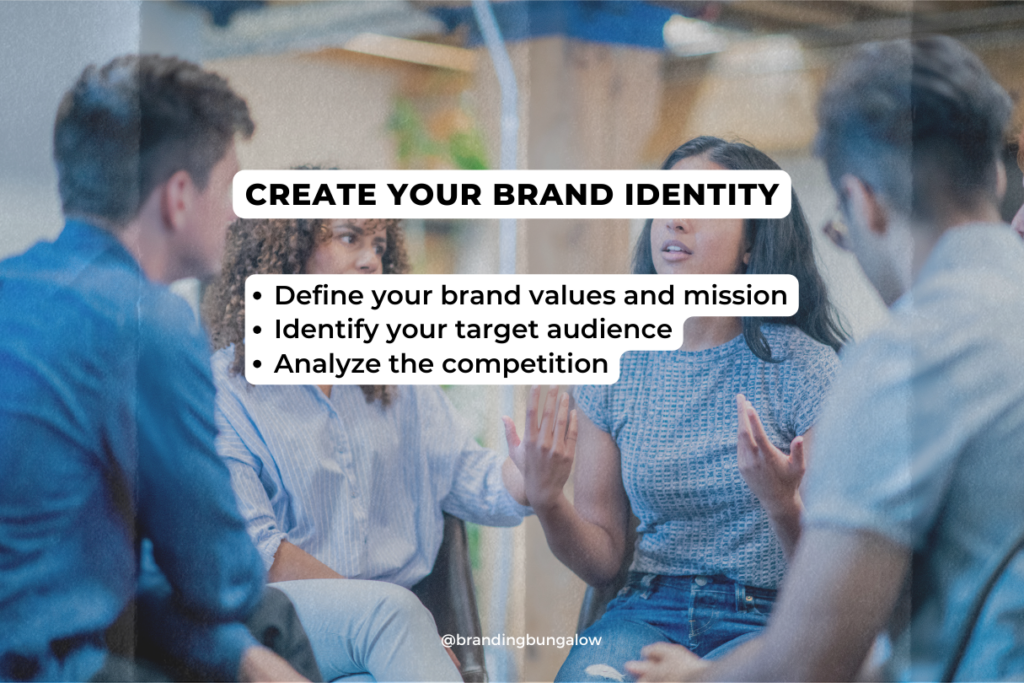How to Create a Brand Identity for Service Providers
As the market is overwhelmed with a variety of businesses competing for attention, having an effective brand identity can be extremely beneficial in making your company stand out from its competitors. With our definitive guide on creating a strong brand identity that engages and resonates with consumers this year, you’ll have all the essential tools needed to set your business apart from others and create lasting impressions!
Short Summary
- Creating a strong brand identity is essential for building customer loyalty and trust.
- Differentiate yourself from competitors by having a unique identity that aligns with customer values and preferences.
- Monitor & refine your brand to stay up-to-date with market changes & resonate with your audience.
The Importance of Brand Identity

A distinct and unforgettable brand identity is essential for the success of a business. It distinguishes your product or service from rivals, creating customer loyalty, and developing trust in customers. Visual cues, core values along with messaging can be combined to make an unified impression that captures and retains clients’ attention – think Nike’s logo instantaneously sparking ideas about athletic ability as well as modernity. Apple showcasing classiness while staying minimalistic. Why do these elements matter so much? How does it influence firms? What type of relation exists between distinctive brands identities? These questions are worth discussing further!
Differentiating Brand Identity from Competitors
It’s key to be distinct in today’s flooded market, and developing a unique brand identity is the way to go. Following established branding regulations while keeping consistency across all communications will ensure that your logo remains distinct and memorable for potential consumers. As an example, Trader Joe’s stands out with its eccentric style, which makes them loved by numerous shoppers. To summarize, if done correctly, forming strong brand guidelines can bring great benefits against competitors as well as customer loyalty.
Building Brand Customer Loyalty
Developing a recognizable and unified brand identity can significantly increase customer loyalty, connecting with consumers’ values and preferences on an emotional level. A strong branding strategy that is reflective of the company’s core mission has been shown to build lasting relationships with customers over time. For example, Patagonia’s successful marketing campaign around sustainability initiatives keeps their target market coming back again and again. To foster such dedication among your clientele, it is imperative that you create a new brand image which accurately conveys who you are as well as what appeals to them.
Establishing Trust in your Brand Identity
Creating a strong brand identity is essential to building long-term trust between you and your target audience. When customers perceive that your company embodies its values, delivers on promises, and upholds quality standards, they become more likely to form lasting relationships with the brand, leading it to success. For example, Visa has established itself as a reliable financial services provider thanks in part to their professional image crafted by consistent branding efforts. Ultimately, this consistency helps give them recognition while maintaining customer’s faith in their business objectives.
Developing Your Brand Strategy

Creating a brand identity that will resonate with your target audience and guarantee success for your business starts by establishing a sound basis, this is where forming the brand strategy comes into play. It comprises of defining what values, mission and goals define you, who are you marketing to, and examining how competitive is the market in which you intend to thrive. When armed with all these insights, it becomes possible then to design an effective logo, color palette, etc., as part of creating the desirable branding image.
Defining Your Brand Identity’s Values and Mission
Your brand’s values and mission are the cornerstones of your unique identity. They inform how you operate, distinguish yourself from others in the same space, and give direction to all visuals or messaging used with it. For instance, TOMS. Shoes stands out for their “One for One” philanthropic action, which communicates social responsibility effectively to its target group. Thus, a strong yet authentic branding is fostered by recognizing these key factors of your business ethos.
Identifying Your Target Audience
Creating an identity for your brand that appeals to the desired target audience is key in accomplishing success. Through researching, analyzing customer demographics and discovering their issues, you can build a personalized identity that resonates with them. This involves tailoring services according to needs as well as developing marketing strategies which they will interact positively with. Thus creating increased satisfaction and loyalty from consumers towards your business model. To summarize: understanding who it is you want to reach out too gives invaluable insight into what kind of message works best for effective engagement, one tailored specifically at building a strong brand identity within your targeted market demographic!
Analyzing the Competitive Landscape
To develop an eye-catching brand identity, it’s essential to evaluate the competition. Analyzing your opponents’ branding practices can allow you to identify any disparities and chances for setting yourself apart from everyone else. This allows you to craft a one of a kind approach that will help make sure your mark stands out in its respective market sector.
An example is Warby Parker who took advantage of their discernment when they observed there was room in the eyewear market for stylish yet economical glasses. Capitalizing on this with their new cutting edge direct-to-consumer model.
Designing Your Visual Brand Elements

With an effective brand strategy at the foundation, it’s time to bring your identity to life through visual components. This can include designing a memorable logo, curating consistent imagery and selecting typography with fitting colors from a chosen color palette – all of which form together into one unified yet unforgettable representation of your company’s values and essence.
So let us look closer into each element separately in order for you to create a strong memorandum of who you are as a business! We will design that iconic logo evoking familiarity every step along the way plus use images authentically associated with what we want our customers remember about us while opting for typefaces that truly convey feel and spirit right off page. Within careful selection so as not to compromise overall aesthetic balance involved when these elements combine together forming exactly how people associate our organization uniquely.
Creating a Memorable Logo
Your logo is a crucial part of establishing your brand identity and making an impactful impression. Make sure it stands out by investing in professional design from a talented graphic designer – this will make for a more unique, customized look that accurately reflects the essence of your brand. Generic online logo generators won’t offer you the same quality or protection against potential intellectual property issues. To truly communicate who you are as a company to customers, creating a memorable logo is essential!
Choosing a Color Palette

When selecting a color scheme for your brand, think carefully about the emotions and associations you wish to bring out. It is important that it stands apart from rival companies’ branding choices while still looking good together as a group of colors. For example, Facebook’s tranquil blues suggest trustworthiness whereas Coca-Cola utilizes bright reds which create an energetic feel.
It is key to consider how these shades can work in harmony with one another while also giving off the desired sentiment when customers view them all at once in association with your company or product.
Selecting Typography
Typography plays an important role in communicating your brand identity and values, which is why its legibility across various platforms should be carefully considered. A high-tech business might lean towards a streamlined sans-serif font, whereas those striving to project luxury could go for a classic serif look. Both decisions will enhance the desired aesthetic of the overall brand image.
Curating Consistent Imagery for your Brand Identity
Creating a strong visual identity for your brand should be the cornerstone of any successful marketing strategy. Choosing images that reflect your values, personality and messaging can give customers a more unified experience with all aspects of your business, from social media content to website materials such as brochures or flyers. A great example is Airbnb: their photographs focus on showcasing unique homes and experiences, which reflects their mission to provide people who travel with somewhere they feel at home in foreign environments.
Crafting Your Brand Voice

Your brand identity’s voice is an important part of your overall presence. It involves the tone and style you utilize in communication to show that your messaging properly reflects what your brand stands for, as well as its personality. Developing a robust branding vocal expression consists of determining both the way it speaks and looks, plus producing material that will appeal to those who encounter it.
Let us go deeper into these elements now.
Tone and Style
It is essential to create a unified tone and style for your brand communication that resonates with your intended audience. Your chosen tones should reflect the personality of your company as well as its values, while making sure that everything remains engaging and attractive. A good way to maintain consistency is through having a comprehensive brand style guide – such as using fun language if you’re looking for an energetic image or adopting formal phrasing when targeting professional services customers. When writing out content related to branding, always consider how it ties into these parameters in order to keep everyone on message across all channels.
Messaging and Content
Creating powerful messaging and content is essential for showing your brand’s distinct value proposition, objective, and story. Your messages should speak to the requirements of those you are trying to reach, their problems areas, as well as things that they enjoy. Meanwhile, your material must stimulate them emotionally in order to link with them effectively.
For instance, Patagonia’s communication strategies center on protecting the environment along with providing top-tier services — a combination which resonates deeply among its intended demographic while emphasizing its core values simultaneously.
Implementing Your Brand Identity

Once your brand identity has been put together, it’s time to roll it out across all platforms and connections. To make sure that this is effective, it requires uniformity in visuals, messaging, tone of voice and for the staff involved to act as a representation for the company’s principles and branding. Let us break down these two ideas further.
Identity Consistency Across Channels
Maintaining consistency in representing your brand identity across all types of marketing channels, both physical and digital, is essential for making sure customers recognize it. This includes webpages, social media profiles, printed materials, as well as any customer service communication they may encounter. By keeping a consistent look and feel to the presentation of their brand’s logo/motto etc., businesses can develop an easily recognizable experience which will make connecting with them more natural for potential clients. Brand recognition cannot be understated when working on creating awareness around what you are offering. Ensuring that your image remains unaltered from one channel to another ensures its success!
Employee Engagement
Employees often serve as a representative of your company to customers, making their relationship with your brand identity critical. To encourage participation in reinforcing and upholding the values associated with your organization’s branding, give employees training programs, initiate internal communications that maintain focus on these goals and cultivate an environment where everyone agrees upon what you stand for.
Not only do engaged staff help create consistency when it comes to how people perceive the business, but they also contribute significantly towards customer commitment and satisfaction levels, two factors essential to success!
Monitoring and Refining Your Brand Identity

Creating a successful brand identity is not something that can be done in one go. It needs continual monitoring and refinement for success. This includes watching how it performs, adjusting to market shifts, and fine-tuning your branding message so that it remains relevant to your target audience at all times. Let’s take an even closer look into this process.
Tracking performance enables you to stay up-to-date with analytics such as interactions or impressions of your messages on various platforms which are vital in measuring efficiency while staying proactive by adapting any changes when necessary allows you remain relevant with people’s interests ensuring long term results from marketing campaigns hence leading to a positive public perception.
Tracking Your Brand Identity’s Performance
It is important to measure the performance of your brand in order to identify areas which require development or growth. Elements that should be taken into consideration may include sales, market share, customer feedback and social impact as these will help indicate any changes necessary for a successful branding strategy tailored to consumer needs and wants. Keeping track of such metrics allows you to effectively adjust or enhance your brand identity so that it remains aligned with current trends while continuing an upward trend overall.
Adapting to Market Changes
Your brand identity must remain current and resonate with your targeted consumers, so it is necessary to adjust accordingly as market conditions and customer needs evolve. This could mean modifying visual elements or even developing new services in order to effectively execute a marketing plan. To ensure the continued success of your brand, stay aware of changes within the marketplace while continually modernizing how you present yourself. Doing this will help guarantee that customers maintain their connection with you.
Summary
By creating a strong brand identity, one is taking an essential step towards securing business success. Crafting such a strategy involves comprehending the importance of having one. Devising and designing compelling visual elements that will build up your brand’s image with your target audience. Forming/developing consistency in terms of both voice and presence across channels, all while constantly monitoring how it evolves over time to refine accordingly. With this understanding firmly instilled within oneself, you are now ready to set about formulating an enduring identity for yourself, more powerful than ever!
Frequently Asked Questions
What are the 7 steps to brand identity?
For a successful brand identity, there are seven essential steps: define your brand’s uniqueness, conduct research on competitors to gain insights and distinguish yourself from them, design visual elements that represent the desired message you want consumers to associate with it (e.g., logos), establish an online presence through various digital channels such as websites and social media accounts. Produce original content relevant for your industry/target audience. Circulate this content via SEO optimization or other means of promotion strategy.
What does a strong brand identity include?
A brand identity comprises logos, typefaces, colors, packaging, messaging and other visuals that symbolize a company’s core values and goals. These design elements help create an identifiable style which creates customer loyalty as well as drawing in new patrons. All these pieces of the branding puzzle must come together to form a cohesive whole – creating the unique personality of each individual business’ overall brand identity.
What are the 5 steps to creating brand identity designs?
Start by defining your business, understanding the market, and developing a logo as well as colors that fit with the desired aesthetic. Make sure to get feedback on these decisions then adjust accordingly. All of this should be incorporated into each asset for creating an effective brand identity.
What factors should I consider when choosing a color palette for my brand?
When picking colors for your brand, contemplate how they will emotionally affect people and how it sets you apart from others. Think about which hues best reflect your company and its principles. Analyze the impact of color psychology on viewers’ views of you. Look at the shades that competitors are using so yours stands out more. Consider all these factors when selecting a suitable color palette for your branding endeavors.
How can I ensure consistency across all marketing channels?
To make sure your brand image is unified and consistent across all marketing avenues, maintain a steady visual aesthetic as well as the same messaging style and tone throughout both digital and physical campaigns. Doing this will help generate an appropriate recognition of your company’s identity for customers that they can easily recognize. It allows you to successfully convey what you need in a lucid way.
Recent Blog Entries
Discounts to Dubsado CRM, Helcim Payment Processing and...
Brand audits can save your business' sinking marketing ship.
What's happening to Coke and what you can learn from it.
Shop Products
Create a personalize brand board by taking elements from our 3 signature brand board templates.